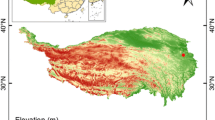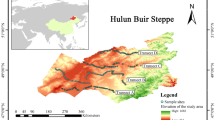Abstract
Over the last few decades, due to increase in grazing intensity, animal trampling has led to soil structure deterioration in Inner Mongolia, China. We investigated two different steppe ecosystems: Leymus chinensis (LCh, characterized by relatively higher precipitation) and Stipa grandis (SG) and two grazing intensities: ungrazed since 1979 (UG79) and grazed (continuously grazed, CG, at the Stipa grandis site and winter grazed, WG, at Leymus chinensis). Soil mechanical and hydraulic properties of semiarid steppe soils from each site and treatment were determined for soil aggregates and disturbed and bulk soil samples from different depths (4–8, 18–22, 30–34 and 56–60 cm for disturbed and bulk samples and 0–15 cm for the aggregates). Grazing causes a significant increase in tensile strength of aggregates and in the precompression stress of the bulk soil as well as a decrease in air and saturated hydraulic conductivity, irrespective of the vegetation type. Furthermore, exclusion from grazing led to more pronounced recovery of soil strength and pore continuity and hydraulic conductivity at the LCh site but it also depended on the moisture conditions of the sites. Under wetter conditions as well as after repeated freezing and thawing the soil strength declined.









Similar content being viewed by others
References
Abid M, Lal R (2009) Tillage and drainage impact on soil quality: II. Tensile strength of aggregates, moisture retention and water infiltration. Soil Tillage Res 103:364–372
Ashman MR, Hallett PD, Brookes PC, Allen J (2009) Evaluating soil stabilisation by biological processes using step-wise aggregate fractionation. Soil Tillage Res 102:209–215
Bachmann J, Woche SK, Goebel M-O (2003) Extended methodology for determining wetting properties of porous media. Water Resour Res 39:1353
Bai Y, Han X, Wu J, Chen Z, Li L (2004) Ecosystem stability and compensatory effects in the Inner Mongolia grassland. Nature 431:181–184
Blanco-Canqui H, Lal R, Owens LB, Post WM, Izaurralde RC (2005) Mechanical properties and organic carbon of soil aggregates in the Northern Appalachians. Soil Sci Soc Am J 69:1472–1481
Broersma K, Krzic M, Newman R, Bomke A (2000) Effects of grazing on soil compaction and water infiltration in forest plantations in the Interior of British Columbia. In: Hollstedt C, Sutherland K, Innes T (eds) Proceedings, From science to management and back: a science forum for the southern interior ecosystems of British Columbia. Southern Interior Forest Extension and Research Partnership, Kamloops, pp 89–92
Bronick CJ, Lal R (2005) Soil structure and management: a review. Geoderma 124:3–22
Bryant R, Doerr SH, Hunt G, Conan S (2007) Effects of compaction on soil surface water repellency. Soil Use Manage 23:238–244
Bullinger-Weber G, Le Bayon R-C, Guenat C, Gobat J-M (2007) Influence of some physicochemical and biological parameters on soil structure formation in alluvial soils. Eur J Soil Biol 43:57–70
Casagrande A (1936) The determination of preconsolidation load and its practical significance. Proceedings of the 1st International Conference on Soil Mechanics and Foundation Engineering, Cambridge 3:60–64
Cetin H (2004) Soil-particle and pore orientations during consolidation of cohesive soils. Eng Geol 73:1–11
Chen SP, Bai YF, Lin GH, Liang Y, Han XG (2005) Effects of grazing on photosynthetic characteristics of major steppe species in the Xilin River Basin, Inner Mongolia, China. Photosynthetica 43:559–565
Czurda KA, Hohmann M (1997) Freezing effect on shear strength of clayey soils. Appl Clay Sci 12:165–187
Dan S, Mengli Z, Bing H, Guodong H (2006) Examining the genetic diversity of Stipa grandis under various grazing pressures. Acta Ecologica Sinica 26:3175–3183
Dekker LW, Ritsema CJ (1996) Variation in water content and wetting patterns in Dutch water repellent peaty clay and clayey peat soils. Catena 28:89–105
Dexter AR, Watts CW (2000) Tensile strength and friability. In: Smith KA, Mullins CE (eds) Soil environmental analysis. Physical methods. Dekker, New York, pp 401–430
Dörner J, Horn R (2009) Direction-dependent behavior of hydraulic and mechanical properties in structured soils under conventional and conservational tillage. Soil Tillage Res 102:225–232
Drewry JJ (2006) Natural recovery of soil physical properties from treading damage of pastoral soils in New Zealand and Australia: a review. Agric Ecosyst Environ 114:159–169
DVWK (1995) Gefügestabilität ackerbaulich genutzter Mineralböden; Teil I: Mechanische Belastbarkeit. Merkblätter zur Wasserwirtschaft Heft 234
Feng X, Nielsen LL, Simpson MJ (2007) Responses of soil organic matter and microorganisms to freeze-thaw cycles. Soil Biol Biochem 39:2027–2037
Görres JH, Savin MC, Amador JA (2001) Soil micropore structure and carbon mineralization in burrows and casts of an anecic earthworm (Lumbricus terrestris). Soil Biol Biochem 33:1881–1887
Greenwood KL, McKenzie BM (2001) Grazing effects on soil physical properties and the consequences for pastures: a review. Aust J Exp Agric 41:1231–1250
Greenwood KL, MacLeod DA, Scott JM, Hutchinson KJ (1998) Changes to soil physical properties after grazing exclusion. Soil Use Manage 14:19–24
Hallaire V, Curmi P, Duboisset A, Lavelle P, Pashanasi B (2000) Soil structure changes induced by the tropical earthworm Pontoscolex corethrurus and organic inputs in a Peruvian ultisol. Eur J Soil Biol 36:35–44
Hallett PD, Young IM (1999) Changes to water repellence of soil aggregates caused by substrate-induced microbial activity. Eur J Soil Sci 50:35–40
Hallett PD, Baumgartl T, Young IM (2001) Subcritical water repellency of aggregates from a range of soil management practices. Soil Sci Soc Am J 65:184–190
Hallett PD, Nunan N, Douglas JT, Young IM (2004) Millimeter-scale spatial variability in soil water sorptivity: scale, surface elevation and subcritical repellency effects. Soil Sci Soc Am J 68:352–358
Hartge KH, Horn R (2009) Die physikalische Untersuchung von Böden. E. Schweizerbart’Sche Verlagsbuchhandlung, Stuttgart
Horn R (1986) The influence of animal treading on soil physical properties of mountainous soils. Mitt Dtsch Bodenkundl Gesellsch 46:64–69
Horn R, Smucker A (2005) Structure formation and its consequences for gas and water transport in unsaturated arable and forest soils. Soil Tillage Res 82:5–14
Horn R, Taubner H, Wuttke M, Baumgartl T (1994) Soil physical properties related to soil structure. Soil Tillage Res 30:187–216
Horn R, Domżał H, Słowińska-Jurkiewicz A, van Ouwerkerk C (1995) Soil compaction processes and their effects on the structure of arable soils and the environment. Soil Tillage Res 35:23–36
Jastrow JD (1996) Soil aggregate formation and the accrual of particulate and mineral-associated organic matter. Soil Biol Biochem 28:665–676
Jongmans AG, Pulleman MM, Balabane M, van Oort F, Marinissen JCY (2003) Soil structure and characteristics of organic matter in two orchards differing in earthworm activity. Appl Soil Ecol 24:219–232
Krümmelbein J, Wang Z, Zhao Y, Peth S, Horn R (2006) Influence of various grazing intensities on soil stability, soil structure and water balance of grassland soils in Inner Mongolia, P.R. China. In: Horn R, Fleige H, Peth S, Peng X (eds) Soil management for sustainability. Advances in GeoEcology. Vol. 38. Catena Verlag, Reiskirchen, pp 93–101
Krümmelbein J, Peth S, Horn R (2008) Determination of pre-compression stress of a variously grazed steppe soil under static and cyclic loading. Soil Tillage Res 99:139–148
Kværnø SH, Øygarden L (2006) The influence of freeze-thaw cycles and soil moisture on aggregate stability of three soils in Norway. Catena 67:175–182
Lesschen JP, Cammeraat LH, Kooijman AM, van Wesemael B (2008) Development of spatial heterogeneity in vegetation and soil properties after land abandonment in a semi-arid ecosystem. J Arid Environ 72:2082–2092
Martinez LJ, Zinck JA (2004) Temporal variation of soil compaction and deterioration of soil quality in pasture areas of Colombian Amazonia. Soil Tillage Res 75:3–17
Mbagwu JSC, Bazzoffi P (1989) Effect of freezing and thawing on the stability of soil aggregates treated with organic wastes. Cold Reg Sci Technol 16:191–199
McGill R, Tukey JW, Larsen WA (1978) Variations of box plots. Am Stat 32:12–16
Mosaddeghi MR, Hajabbasi MA, Khademi H (2006) Tensile strength of sand, palygorskite and calcium carbonate mixtures and the interpretation with the effective stress theory. Geoderma 134:160–170
Mosaddeghi MR, Koolen AJ, Hajabbasi MA, Hemmat A, Keller T (2007) Suitability of pre-compression stress as the real critical stress of unsaturated agricultural soils. Biosystems Eng 98:90–101
Munkholm LJ, Schjønning P, Kay BD (2002) Tensile strength of soil cores in relation to aggregate strength, soil fragmentation and pore characteristics. Soil Tillage Res 64:125–135
Oades JM (1993) The role of biology in the formation, stabilization and degradation of soil structure. Geoderma 56:377–400
Oztas T, Fayetorbay F (2003) Effect of freezing and thawing processes on soil aggregate stability. Catena 52:1–8
Peth S (2004) Bodenphysikalische Untersuchungen zur Trittbelastung von Böden bei der Rentierweidewirtschaft an borealen Wald- und subarktisch-alpinen Tundrenstandorten—Auswirkungen auf thermische, hydraulische und mechanische Bodeneigenschaften. Schriftenreihe des Institut für Pflanzenernährung und Bodenkunde (Christian-Albrechts-Universität Kiel) 64
Peth S, Horn R (2006) Consequences of grazing on soil physical and mechanical properties in forest and tundra environments. In: Forbes BC, Bölter M, Müller-Wille L, Hukkinen J, Müller F, Gunslay N, Konstatinov Y (eds) Ecological studies. Reindeer management in Northernmost Europe. Springer, Berlin, pp 217–243
Peth S, Rostek J, Zink A, Mordhorst A, Horn R (2010) Soil testing of dynamic deformation processes of arable soils. Soil Tillage Res. In press
Pires LF, Cooper M, Cássaro FAM, Reichardt K, Bacchi OOS, Dias NMP (2008) Micromorphological analysis to characterize structure modifications of soil samples submitted to wetting and drying cycles. Catena 72:297–304
Proffitt APB, Bendotti S, McGarry D (1995) A comparison between continuous and controlled grazing on a red duplex soil. I. Effects on soil physical characteristics. Soil Tillage Res 35:199–210
Sander T, Gerke HH, Rogasik H (2008) Assessment of Chinese paddy-soil structure using X-ray computed tomography. Geoderma 145:303–314
Schlichting E, Blume HP, Stahr K (1995) Bodenkundliches Praktikum. Blackwell Wissenschafts-Verlag, Berlin
Semmel H, Horn R, Hell U, Dexter AR, Schulze ED (1990) The dynamics of soil aggregate formation and the effect on soil physical properties. Soil Technol 3:113–129
Shoop S, Affleck R, Haehnel R, Janoo V (2008) Mechanical behavior modeling of thaw-weakened soil. Cold Reg Sci Technol 52:191–206
Six J, Bossuyt H, Degryze S, Denef K (2004) A history of research on the link between (micro)aggregates, soil biota, and soil organic matter dynamics. Soil Tillage Res 79:7–31
Tisdall JM, Oades JM (1982) Organic matter and water-stable aggregates in soils. J Soil Sci 33:141–163
Tobias S, Tietje O (2007) Modelling experts’ judgements on soil compaction to derive decision rules for soil protection-A case study from Switzerland. Soil Tillage Res 92:129–143
Tollner EW, Calvert GV, Langdale G (1990) Animal trampling effects on soil physical properties of two Southeastern U.S. ultisols. Agric Ecosyst Environ 33:75–87
Urbanek E, Hallett P, Feeney D, Horn R (2007) Water repellency and distribution of hydrophilic and hydrophobic compounds in soil aggregates from different tillage systems. Geoderma 140:147–155
Venables WN, Smith DM, the R Development Core Team (2009) An introduction to R. Notes on R: a programming environment for data analysis and graphics. Version 2.10.1 (2009-12-14). Available at http://www.r-project.org. Accessed 16 April 2010
Wiesmeier M, Steffens M, Kölbl A, Kögel-Knabner I (2009) Degradation and small-scale spatial homogenization of topsoils in intensively-grazed steppes of Northern China. Soil Tillage Res 104:299–310
Yong-Zhong S, Yu-Lin L, Jian-Yuan C, Wen-Zhi Z (2005) Influences of continuous grazing and livestock exclusion on soil properties in a degraded sandy grassland, Inner Mongolia, northern China. Catena 59:267–278
Acknowledgements
The authors are highly indebted to the German Research Foundation (DFG) for the financial support of this research group MAGIM (Forschergruppe 536 MAGIM—Matter fluxes in grasslands of Inner Mongolia as influenced by stocking rate) as well as they would like to thank Xingguo Han, Yongfei Bai and the Institute of Botany (Chinese Academy of Sciences) for the opportunity to work at IMGERS.
Author information
Authors and Affiliations
Corresponding author
Additional information
Responsible Editor: Ingrid Koegel-Knabner.
Rights and permissions
About this article
Cite this article
Reszkowska, A., Krümmelbein, J., Peth, S. et al. Influence of grazing on hydraulic and mechanical properties of semiarid steppe soils under different vegetation type in Inner Mongolia, China. Plant Soil 340, 59–72 (2011). https://doi.org/10.1007/s11104-010-0405-3
Received:
Accepted:
Published:
Issue Date:
DOI: https://doi.org/10.1007/s11104-010-0405-3




